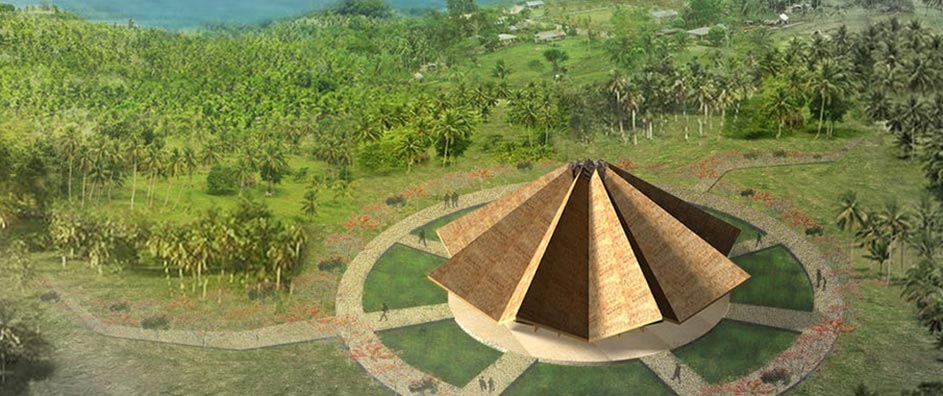In a momentous development for the island of Tanna in Vanuatu, the design for the local Baha’i House of Worship was recently unveiled.
The captivating architectural design of the House of Worship, in its simple yet striking form, takes its inspiration from the coconut and banyan trees of the island and the natural forms of the landscape.
“This structure will be the embodiment of serenity and represent the archipelago’s history and culture,” said Ashkan Mostaghim, the Temple’s architect.
Double-sided roofs made of reeds and sugar-cane leaves rise to a central point, making the Temple appear as a nine-pointed star. The walls of the House of Worship are designed to be created using stakes and plaited reeds, drawing on the local architecture of the region.

An interior view of the Temple, which will seat 300 people.
“The interior space is defined by light,” said Mr. Mostaghim. Throughout the day, light will stream through the open screens and delicate glass oculus. The Temple has space for 300 visitors and a choir—both for community devotions and private meditation and prayer in a space of spiritual serenity.
Like all Baha’i Houses of Worship, the Vanuatu temple will welcome everyone, of all Faiths and no Faith:
O people of the world! Build ye houses of worship throughout the lands in the name of Him Who is the Lord of all religions. Make them as perfect as is possible in the world of being, and adorn them with that which befitteth them … Then, with radiance and joy, celebrate therein the praise of your Lord, the Most Compassionate. Verily, by His remembrance the eye is cheered and the heart is filled with light. – Baha’u’llah, The Most Holy Book, pp. 29-30.

The joyful celebration for the unveiling of the design of the local House of Worship included children, youth, and adults.
A jubilant celebration in Tanna on 18 June 2017 marked the unveiling of the Temple’s design. The program included readings from different sacred texts, signifying that the Temple is open to all.
The House of Worship will enhance the vibrant community life on Tanna. A sense of collective ownership of the Temple, even before its design had been unveiled, was already present in the consciousness of the island’s inhabitants. In the early stages of the design process, numerous people from the island, including chiefs and other tribal leaders, submitted ideas for the structure of the central edifice and gathered for meetings to discuss its purpose and implications for their society.
“The design of the House of Worship in Tanna has been inspired by the Baha’i writings, and we have endeavored to portray its principles in the structure,” said the architect. The Temple will uniquely symbolize the unity of all people and the integral connection of worship of God and service to humanity:
Although to outward seeming the [Baha’i House of Worship]is a material structure, yet it hath a spiritual effect. It forgeth bonds of unity from heart to heart; it is a collective centre for men’s souls. – Abdu’l-Baha, Selections from the Writings of Abdu’l-Baha, p. 95.
Known in the Baha’i writings as “the dawning-place of the praise of God” (or Mashriqu’l-Adhkar in Arabic), the House of Worship is not simply a temple—instead, it is meant to include philanthropic institutions like schools, hospitals, hospices and other dependencies dedicated to the social, humanitarian, educational and scientific advancement of humanity:
The Baha’i House of Worship is dedicated to the praise of God. The House of Worship forms the central edifice of the Mashriqu’l-Adhkar (the Dawning-place of the Praise of God), a complex which, as it unfolds in the future, will comprise in addition to the House of Worship a number of dependencies dedicated to social, humanitarian, educational, and scientific pursuits. Abdu’l-Baha describes the Mashriqu’l-Adhkar as “one of the most vital institutions in the world,” and Shoghi Effendi indicates that it exemplifies in tangible form the integration of “Baha’i worship and service.” Anticipating the future development of this institution, Shoghi Effendi envisages that the House of Worship and its dependencies “shall afford relief to the suffering, sustenance to the poor, shelter to the wayfarer, solace to the bereaved, and education to the ignorant.” In the future, Baha’i Houses of Worship will be constructed in every town and village. – Ibid., The Universal House of Justice, pp. 190-191.
















Comments
Sign in or create an account
Continue with Googleor